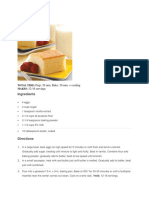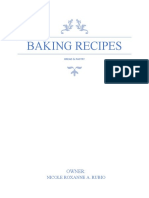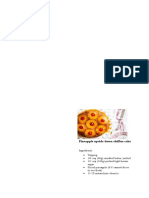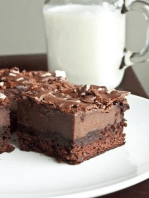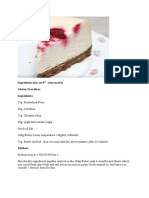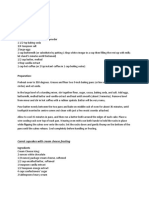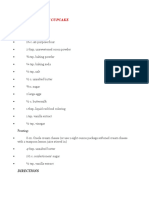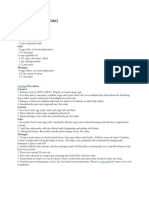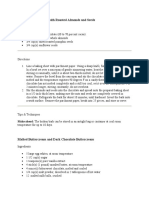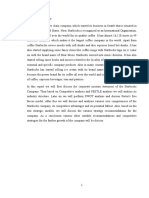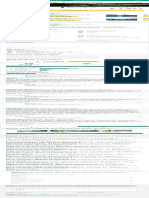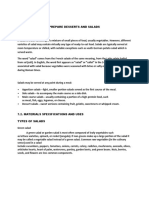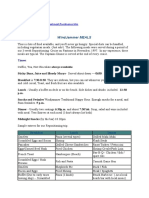Professional Documents
Culture Documents
Dessert Recipes
Dessert Recipes
Uploaded by
Stephanie NgOriginal Description:
Copyright
Available Formats
Share this document
Did you find this document useful?
Is this content inappropriate?
Report this DocumentCopyright:
Available Formats
Dessert Recipes
Dessert Recipes
Uploaded by
Stephanie NgCopyright:
Available Formats
Almond Cake by Claudia Roden 1/2 lb.
(1-3/4 cups) blanched whole almonds 6 large eggs, separated 1-1/4 cups superfine sugar Grated zest of 1 orange Grated zest of 1 lemon 4 drops almond extract Confectioners' sugar for dusting
Finely grind the almonds in a food processor. With an electric mixer, beat the egg yolks with the sugar to a smooth pale cream. Beat in the zests and almond extract. Add the ground almonds and mix very well. With clean beaters, beat the egg whites in a large bowl until stiff peaks form. Fold them into the egg and almond mixture (the mixture is thick, so you will need to turn it over quite a bit into the egg whites). Grease an 11-inch springform pan, preferably nonstick, with butter and dust it with flour. Pour in the cake batter, and bake in a preheated 350F oven for 40 minutes, or until it feels firm to the touch. Let cool before turning out. Just before serving, dust the top of the cake with confectioners' sugar. Or, if you like, cut a St. James cross out of paper. Place it in the middle of the cake, and dust the cake with confectioners' sugar, then remove the paper.
Yogurt Cake with Chocolate Ganache Frosting by Tony Rosenfeld For the cake 4 oz. (1/2 cup) unsalted butter, softened, more for the pan 9 oz. (2 cups) unbleached all-purpose flour 1 tsp. baking powder 1 tsp. baking soda 1/4 tsp. table salt 1 cup granulated sugar 3 large eggs 1-1/2 cups plain yogurt (low-fat or full-fat) 2 tsp. pure vanilla extract For the ganache frosting 3/4 cup heavy cream 8 oz. semisweet chocolate, broken into small pieces 1 Tbs. light corn syrup Make the cake Position a rack in the center of the oven and heat the oven to 350F. Butter a 9-inch cake pan. Line the pan with a piece of parchment paper cut to size. In a medium bowl, whisk together the flour, baking powder, baking soda, and salt. In a stand mixer fitted with a paddle attachment or in a large bowl with an electric hand mixer, cream the sugar and butter on medium speed until smooth and fluffy. Reduce the speed to low, add the eggs, and then add the yogurt and vanilla, scraping down the sides of the bowl as needed. Add the dry ingredients and mix until just incorporated. Transfer the batter to the prepared pan and bake until a toothpick inserted into the center comes out clean, about 45 minutes. Let cool completely on a rack before turning the cake out of the pan. Make the frosting and frost the cake Bring the cream to a simmer in a small saucepan over medium heat. Reduce the heat to low, add the chocolate and corn syrup, and whisk until the chocolate is completely melted. Remove from the heat and let cool for 15 minutes. Transfer to a large bowl and refrigerate uncovered, stirring every 30 minutes or so, until it firms to a spreadable texture, about 45 minutes. Transfer the cake
to a cake plate. Spread the ganache evenly over the top and sides of the cake with an offset spatula. Make Ahead Tips The frosted cake can be refrigerated for up to five days in an airtight cake container (return to room temperature before serving).
Classic Cheesecake by Abigail Johnson Dodge Serves 10 to 12 Yields 1 9-inch cheesecake
8 oz. graham crackers, finely crushed (2 cups of crumbs) 3 Tbs. granulated sugar 7 Tbs. unsalted butter, melted 4 8-oz. packages cream cheese, at room temperature 2 Tbs. all-purpose flour Table salt 1-1/4 cups granulated sugar 1 Tbs. pure vanilla extract 4 large eggs, at room temperature
Position a rack in the center of the oven and heat the oven to 375F. In a medium bowl, stir together the graham cracker crumbs and 3 Tbs. granulated sugar. Mix in the melted butter until the crumbs are evenly moist and clump together slightly. Transfer the mixture to a 9-inch springform pan and press evenly onto the bottom and about 2 inches up the sides of the pan (to press, use plastic wrap or a flat-bottom measuring cup). Bake until the crust is fragrant and slightly darkened, 9 to 12 minutes. Let the pan cool on a rack. Lower the oven temperature to 300F. In a stand mixer fitted with the paddle attachment, beat the cream cheese, flour, and a pinch of table salt on medium speed, scraping down the sides of the bowl and the paddle frequently, until very smooth and fluffy, about 5 minutes. Make sure the cheese has no lumps. Add the 1-1/4 cups granulated sugar and continue beating until well blended and smooth. Add the vanilla and beat until blended, about 30 seconds. Add the eggs one at a time, beating just until blended. (Don't overbeat once the eggs have been added or the cheesecake will puff too much and crack as it cools.) Pour the filling into the cooled crust and smooth the top. Bake at 300F until the center jiggles like Jell-O when nudged, 55 to 65 minutes. The cake will be slightly puffed around the edges, and the center will still look moist. Set on a rack and cool completely. Cover and refrigerate until well chilled, at least 8 hours and up to 3 days. The cake can also be frozen at this point for up to 1 month. (To freeze, put the unmolded, cooled cake on a
rimmed baking sheet in the freezer, uncovered, until the top is cold and firm; then wrap it in two layers of plastic and one layer of foil. Thaw overnight in the refrigerator.) Unclasp and remove the side of the springform pan and run a long, thin metal spatula under the bottom crust. Carefully slide the cake onto a flat serving plate. To serve, run a thin knife under hot water, wipe it dry, and cut the cake into slices, heating and wiping the knife after every slice.
Sour Cream Coffee Cake with Brown Sugar Streusel by Nicole Rees Serves nine. Yields one 8-inch square cake. For the Streusel 3/8 oz. (3/4 cup) all-purpose flour; more for the pan 1/2 cup packed light brown sugar 1/2 tsp. ground cinnamon 1/8 tsp. table salt 1/4 oz. (4-1/2 Tbs.) unsalted butter, melted; more if needed For the Cake 1/2 cup sour cream, at room temperature 1 tsp. pure vanilla extract 2 drops pure almond extract 4 oz. (1/2 cup) very soft unsalted butter; more for the pan 3/4 cup granulated sugar 1 large egg yolk, at room temperature 1 large egg, at room temperature 1/4 plus 1/8 tsp. table salt 5-1/4 oz. (1-1/3 cups) cake flour 1 tsp. baking powder 1/8 tsp. baking soda Make the streusel In a small bowl, stir the flour, brown sugar, cinnamon, and salt. Drizzle the melted butter over the dry ingredients and stir until well combined. The streusel should feel clumpy, not sandy, when gently squeezed between your fingertips. If it seems dry, add more melted butter. Make the cake Position a rack in the center of the oven and heat the oven to 350F. Lightly butter the bottom and sides of a 8-inch square metal cake pan. Line the bottom of the pan with parchment and butter the parchment. Dust the pan with flour, tapping out any excess. In a small bowl, whisk the sour cream, vanilla, and almond extract. 23-
In a large bowl, cream the butter, granulated sugar, and egg yolk with a wooden spoon until blended, about 20 seconds. Using a whisk, whisk in the whole egg and salt and continue to whisk until the batter is smooth and the sugar begins to dissolve, about 30 seconds. Whisk in the sour cream mixture. Sift the cake flour, baking powder, and baking soda directly onto the batter. Whisk until the mixture is smooth and free of lumps. Spread the batter evenly in the pan. Sprinkle the streusel over the batter, squeezing it with your fingertips to form small clumps. Bake until puffed and golden and a skewer inserted in the center of the cake comes out with only moist crumbs clinging to it, 28 to 30 minutes. Set the pan on a rack to cool for 15 minutes. Run a knife between the cake and the sides of the pan. Invert the cake onto the rack and remove the parchment. Invert again onto a serving plate, so the streusel is on top. Let cool at least 10 minutes before serving. This cake is best served warm.
Southern Devils Food Cake by David Guas For the Ganache 1 lb. semisweet chocolate (preferably 58% cacao), finely chopped 2 cups heavy cream 1 oz. (2 Tbs.) unsalted butter, softened For the Cake 6 oz. (3/4 cup) unsalted butter, softened; more for the pans 8 oz. (1-3/4 cups) all-purpose flour; more for the pans 2 cups packed dark brown sugar 2 tsp. pure vanilla extract 3 large eggs, at room temperature 2-1/4 oz. (3/4 cup) unsweetened Dutch-processed cocoa powder 1-1/4 tsp. baking soda 1 tsp. baking powder 1 tsp. kosher salt 1-1/2 cups buttermilk, preferably low fat, at room temperature 1/4 cup mayonnaise Make the Ganache Put the chopped chocolate in a medium bowl. Bring the cream to a boil in a 2-quart saucepan over medium-high heat. Pour the hot cream directly over the chocolate and let it sit without stirring for 5 minutes. Using a whisk, stir in the center of the mixture in a small, tight circular motion until fully combined. Add the butter and stir until it is fully incorporated. Put a piece of plastic wrap directly onto the surface of the ganache and set aside at room temperature for at least 8 hours or overnight. Make the Cake Position a rack in the center of the oven and heat the oven to 350F. Butter two 8x2-inch round cake pans and line each with a parchment round. Butter the parchment, dust with flour, and tap out any excess.
In a stand mixer fitted with the paddle attachment, beat the butter, brown sugar, and vanilla on medium-high speed until lighter in color and slightly increased in volume, 3 to 5 minutes. Lower the speed to medium and add the eggs, one at a time, mixing until each is fully incorporated before adding the next Sift the flour, cocoa powder, baking soda, and baking powder onto a piece of parchment. Add the salt to the dry ingredients after sifting. Using the parchment as a chute, add one-quarter of the dry ingredients to the batter and mix on low speed until incorporated. Add about 1/2 cup of the buttermilk and mix on low speed until incorporated. Continue to alternate dry ingredients and buttermilk, mixing until incorporated after each addition and stopping to scrape the bowl and beater as necessary. Using a whisk, fold the mayonnaise into the batter. Divide the batter evenly between the prepared pans and bake until a toothpick inserted in the center of the cakes comes out clean and the sides of the cake have begun to pull away from the pan slightly, 40 to 45 minutes. Remove the pans from the oven and cool on a rack for 15 minutes. Invert the cakes onto the rack and remove the pans and parchment. Cool the cakes completely. Assemble the Cake With a serrated knife, cut each cake in half horizontally. Put one of the base layers on a cake plate and tuck strips of waxed paper under the cake to keep the plate clean while icing the cake. Top the cake with about 1/3 cup of the ganache, spreading it evenly over the top. Add another cake layer, top with ganache, and repeat until the last layer is in place. Spread a thin layer of ganache over the top and sides of the cake and refrigerate for 15 minutes to seal in any crumbs. Spread the remaining ganache over the top and sides. Remove the waxed paper. Make Ahead Tips The cake layers may be baked 1 day ahead; wrap well and store at room temperature. The filled and frosted cake may be refrigerated, covered, for up to 2 days. Return to room temperature 2 hours before serving.
Chocolate Chip-Banana Bread by Carolyn Weil 4 oz. (1/2 cup) unsalted butter, softened; more for the pans 10-1/2 oz. (2-1/3 cups) unbleached all-purpose flour; more for the pans 1 tsp. baking powder 1/2 tsp. baking soda 1/2 tsp. table salt 1 cup granulated sugar 3 large eggs 1 cup mashed very ripe banana (2 large or 3 medium bananas) 1/2 cup buttermilk 1/2 cup semi-sweet chocolate chips
Position a rack in the middle of the oven and heat the oven to 350F. Lightly butter and flour four mini loaf pans, one 12-cup Bundt pan, or one 9x5-inch metal loaf pan. Combine the flour, baking powder, baking soda, and salt in a medium mixing bowl. Whisk the ingredients well to combine. In the bowl of a stand mixer or in a medium mixing bowl, mix the butter on low speed with the stand mixers paddle attachment or on medium-low speed with a hand mixer until smooth. Add the sugar gradually and continue mixing on low speed until slightly fluffy. Add the eggs one at a time, mixing until smooth between each addition. Add the bananas, scrape down the sides of the bowl, and mix until blended. Stop the mixer and add half the flour mixture. Mix on low speed (for either mixer) until the flour drifts are almost gone. Add half the buttermilk. Mix until blended, and then repeat with the remaining flour and buttermilk. Continue mixing until smooth, scraping the bowl to make sure the batter is even. Stir in the chocolate chips by hand. If using mini loaf pans, divide the batter evenly among the four pans (the pans should be about two-thirds full). If using a Bundt or full-size loaf pan, spread the batter in the pan (again, filling the pan no more than two-thirds full.) Smooth the top of the batter. Bake until the loaves are golden and a skewer or toothpick inserted into the center comes out clean, about 40 minutes for mini loaves (60 minutes for a Bundt pan and 60 to 70 minutes for a full-size loaf pan).
Let the loaves cool in the pans on a rack for 10 to 15 minutes to give them time to set and then turn them out onto a rack and flip right side up to cool completely.
Caramel-Pecan Brownies by Tish Boyle For the brownies 6 oz. (12 Tbs.) unsalted butter, cut into 1/2-inch pieces; more softened for the pan 4 oz. unsweetened chocolate, coarsely chopped 4 large eggs 1-3/4 cups granulated sugar 1-1/2 tsp. pure vanilla extract 1/4 tsp. table salt 3-3/8 oz. (3/4 cup) unbleached all-purpose flour 3/4 oz. (1/4 cup) natural cocoa powder 1-1/2 cups pecans, coarsely chopped Tip: For the best results, measure your flour by weight instead of volume. (1 cup of all-purpose flour equals 4-1/2 oz.) If you dont have a scale, be sure to use the proper technique when filling your measuring cups. For the topping 1 recipe Basic Caramel 1/2 cup heavy cream 3 Tbs. unsalted butter, cut into 3 pieces 1 tsp. pure vanilla extract 1/4 tsp. table salt For the garnish 2 oz. bittersweet chocolate, coarsely chopped 1 Tbs. heavy cream 1/2 cup pecans, toasted and chopped Make the brownies Position a rack in the center of the oven and heat the oven to 350F. Butter the bottom and sides of a 9x13-inch baking pan. Put the butter and chocolate in a medium heavy-duty saucepan over low heat and stir constantly until melted and smooth. Remove from the heat and set aside. In a medium bowl, whisk the eggs until well blended. Gradually whisk in the sugar and then whisk vigorously until well blended. Whisk in the melted chocolate mixture, vanilla extract, and
salt. Whisk in the flour and cocoa powder until blended. Stir in the pecans and then scrape the batter into the prepared pan, smoothing it into an even layer with a spatula. Bake until a toothpick inserted in the center of the brownies comes out with a few moist crumbs clinging to it, 20 to 22 minutes. Transfer the pan to a wire rack and, if necessary, gently press down any puffed areas with a spatula to make the top level. Let cool about 5 minutes. Make the topping While the brownies are baking, make the Basic Caramel according to the directions. Remove the pan from the heat and carefully add the creamthe mixture will bubble up furiously. Once the bubbling has subsided, add the butter and gently whisk until completely melted. Whisk in the vanilla extract and salt. Pour the caramel topping over the brownies, using a spatula to spread it evenly over the entire top. Let the brownies cool on the rack for 45 minutes and then refrigerate until the caramel topping is set, at least 1 hour. Garnish the brownies Combine the chocolate and heavy cream in a small saucepan over low heat and stir constantly until melted and smooth. Pour the chocolate into a small piping bag fitted with a 1/8-inch plain tip. (Or put it in a small zip-top bag and seal the bag. Using scissors, snip off a corner of the bag to make a small hole.) Drizzle the chocolate over the brownies in a zigzag pattern. Sprinkle the chopped pecans over the top. Refrigerate until the chocolate is set, about 30 minutes. Cut the brownies into 36 rectangles. Serve chilled or at room temperature. Make Ahead Tips Well-covered brownies will keep at room temperature for up to 2 days and in the refrigerator for up to 5 days.
Angel Food Cake with Strawberries & Whipped Cream by Barbara Lynch For the cake: 1-1/2 cups egg whites (from 11 large eggs) 4 oz. (3/4 cup plus 2 Tbs.) all-purpose flour 1-1/2 cups granulated sugar Pinch kosher salt 2 Tbs. fresh lemon juice 1-1/2 tsp. pure vanilla extract For the strawberries: 3/4 lb. strawberries, hulled and sliced (about 3 cups) 2 Tbs. granulated sugar 1 Tbs. Grand Marnier (optional) Lightly sweetened whipped cream, for serving Make the cake: Put the egg whites in the bowl of a stand mixer fitted with the whisk attachment and let them warm until theyre a little cooler than room temperature (about 60F), about 1-1/2 hours. (To speed up this step, set the mixer bowl in a bowl of lukewarm water and stir the whites occasionally; check the temperature frequently.) Position a rack in the bottom third of the oven and heat the oven to 325F. Have ready a 10-inch tube pan with removable bottom. Sift together the flour, 1/2 cup of the sugar, and the salt; set aside. Add the lemon juice to the egg whites and beat on medium-low speed until the mixture is quite frothy and has increased a little in volume, 1 to 2 minutes. Increase the speed to medium and slowly, about a tablespoon at a time, add the remaining 1 cup of sugar. Continue beating until the whites thicken and form soft droopy peaks when the beater is lifted, 6 to 7 minutes from when you began adding sugar. Do not beat the whites until stiff. In the final minute or so of beating, add the vanilla extract. The mixture should be voluminous and light but still fluid enough to pour. Sprinkle about one fifth of the flour and sugar mixture over the egg whites and with a large spatula, gently fold it in. Continue folding in the remaining flour-sugar mixture in 4 more additions until its fully incorporated. Gently pour the batter into the ungreased tube pan. Run a
spatula once through the batter to eliminate any big air bubbles and then lightly smooth the batter if necessary. Bake until the top is a light golden color and the cake feels spongy and springs back when touched very lightly, 45 to 55 minutes. Prepare the strawberries: Meanwhile, toss the berries with the sugar and Grand Marnier (if using) and refrigerate for at least 1 hour before serving (you can prepare the berries up to 6 hours ahead). When the cake is done, insert the neck of a bottle or a funnel into the tube part of the pan and invert the pan. Let the cake cool completely before removing it from the pan. (Cooling the cake upside down keeps it from collapsing before it cools, and elevating it on a bottle or funnel helps air circulate for faster cooling.) To remove the cake, run a thin knife or spatula around it to loosen it. Lift the cake (still on the tube section) from the pan. Run the knife or spatula between the cake and the bottom of the pan. Invert the cake onto a cake plate and remove the tube section. Slice the cake with a serrated knife using a gentle sawing motion. Serve topped with the strawberries and a dollop of whipped cream.
Orange Layer Cake by Ris Lacoste For the filling: 2/3 cup sugar 3 Tbs. all-purpose flour 1 cup fresh orange juice (from about 3 large or 4 medium oranges), without pulp 2 large egg yolks 2 Tbs. salted butter For the cake: 2-1/4 cups (101/8 oz.) all-purpose flour 2-1/2 tsp. baking powder 1 tsp. salt 1/3 cup salted butter 1/3 cup vegetable shortening 2 tsp. grated orange zest (from about 1 large orange) 1-1/2 cups sugar 3 large eggs 1 cup fresh orange juice (from about 3 large or 4 medium oranges), without pulp For the frosting: 6 oz. (12 Tbs. ) salted butter, at room temperature 4-1/2 cups (about 18 oz.) confectioners sugar Dash salt 1 tsp. grated orange zest 5 Tbs. fresh orange juice For the garnish: 1 or 2 small oranges, sliced thinly, slices cut halfway through on one side, laid on paper towels to drain 7 or 8 sprigs fresh mint (pick pairs of leaves)
Make the filling: Combine the sugar and the flour in a heavy-based saucepan. Whisk just to mix. Add the orange juice and egg yolks and whisk vigorously again to combine. Put the saucepan over medium-high heat and cook, whisking constantly, until the mixture boils (3 to 4
min.). Cook another 1 min., stirring constantly (the mixture will thicken noticeably and become less cloudy). Be sure it boils for 1 min. so that the filling will thicken enough to support the cake. Remove from the heat and stir in the butter. Transfer to a bowl, cover with plastic wrap (lay the wrap directly on the fillings surface), and refrigerate. Chill thoroughly before using. Make the cake: Heat the oven to 350F. Sift together the flour, baking powder, and salt. Grease two 9x1-1/2-inch cake pans and line the bottom of each with a round of kitchen parchment. Lightly flour the sides and bottom of each pan. In a mixer, cream together the butter, shortening, and zest. Gradually add the sugar, creaming until the mixture is light and fluffy. Scrape down the sides of the bowl. Add the eggs, one at a time, mixing well between additions and scraping down the sides. Add the sifted dry ingredients alternately with the orange juice to the creamed mixture, beating well on low speed after each addition. Pour equal amounts of the batter into the two prepared cake pans. Tap the pans on the counter before putting them in the oven to remove any air bubbles and to even the batter. Bake until a toothpick inserted in the middle comes out clean, about 28 min. Cool the cake layers in the pans for 10 min. and then loosen the layers by running a knife between the cake and the edge of the pan. Remove the layers from the pans and put them on a rack to continue cooling. Make the frosting: Cream the butter in the mixer. Add the confectioners sugar and salt and combine thoroughly. Add the orange zest and mix to combine. Add the orange juice and mix on high speed until well blended, scraping down the sides. It will be light and creamy. Refrigerate if not using right away. Assemble the cake: When all the components are cool, put one cake layer on a cake stand or a cardboard cake round. Spread the orange filling over the cake to make a 1/4-inch layer. Youll have about 1/3 cup extra filling; serve it alongside the cake, if you like. Put the second layer on top of the first and refrigerate the cake until the filling has chilled again and firmed up, about 45 min.
Spread the filling. Loosen the frosting by beating with a spatula (if its very stiff, beat it with an electric mixer). Using an icing spatula, spread just a very thin layer of frosting over the whole cake (this is called a crumb coat because it secures loose crumbs) and refrigerate the cake to let the frosting firm up, about 10 min. Put on the final coat of frosting, taking care to work gently, as the top layer of the cake tends to slide around ever so slightly because of the filling. If it slides, just push it back. Create a pattern on the frosting using the icing spatula (heat it up under warm water and dry it). Transfer the cake (on its cardboard or by lifting it with spatulas) to a cake plate or pedestal.
Apply a thin layer of frosting with an icing spatula.
Create a pattern on the final coat of frosting. Garnish the cake: Twist the orange slices into S shapes and put seven or eight around the top of the cake. Tuck a pair of mint leaves into each orange twist.
Vanilla Layer Cake with Whipped Rum-Ganache Icing by Greg Case For the cake: 6 oz. (12 Tbs.) unsalted butter, at room temperature; more for the cake pans 10-1/4 oz. (2-1/4 cups) unbleached all-purpose flour; more for the cake pans 2 tsp. baking powder 3/4 tsp. table salt 3 large eggs, at room temperature 4 large egg yolks, at room temperature 3 Tbs. vegetable oil 2 tsp. pure vanilla extract 2 cups granulated sugar 3/4 cup buttermilk, at room temperature For the whipped ganache: 12 oz. semisweet chocolate (55 to 60%), coarsely chopped or broken into pieces (2 slightly heaping cups) 2 cups heavy cream 2 to 3 Tbs. dark rum or brandy Make the cake: Position a rack in the center of the oven and heat the oven to 350F. Butter and flour two 9x2inch round cake pans and line the bottoms with parchment. In a medium bowl, whisk the flour, baking powder, and salt. In another medium bowl, whisk the eggs, yolks, oil, and vanilla. In the bowl of a stand mixer fitted with the paddle attachment, mix the butter on medium-high speed until smooth and light in color, about 2 minutes. Scrape the sides of the bowl with a rubber spatula. Add the sugar and mix on medium-high speed until very well blended, about 2 minutes longer. Scrape the bowl again. With the mixer running on medium-high speed, add the egg mixture to the butter mixture in a steady stream. Beat until light and fluffy, about 2 minutes.
Reduce the mixer speed to low. Add half the dry ingredients to the butter mixture and mix until combined. Add half the buttermilk and mix until combined. Repeat with remaining flour and buttermilk. Scrape the sides of the bowl and divide the batter evenly between the prepared pans. The batter will be thick; spread it in the pans as smoothly as possible. Bake the cakes until they're golden-brown on top and a toothpick inserted into the middle of each cake comes out clean, 30 to 35 minutes. Cool them in the pan for 15 to 20 minutes on a cooling rack and then turn them out onto a rack and cool completely. Make the whipped ganache: While the cake cools, prepare the ganache. Clean and dry the stand mixer bowl. Grind the chocolate in a food processor until it reaches the consistency of coarse meal, about 30 seconds. Bring the cream to a boil in a small saucepan over medium heat. Add the cream and rum to the food processor and process until smooth, 10 to 20 seconds. Transfer to the cleaned and dried mixer bowl and refrigerate, stirring occasionally, until the ganache reaches 55 to 65F, about 11/2 hours. In the stand mixer fitted with the whisk attachment, whip the chilled ganache on medium-high speed until lightened in color and fluffy, about 1 minute. Don't overwhip, or the ganache may seize. Scrape the sides of the bowl with a rubber spatula and mix gently. Assemble the cake: Put one cake layer on a cake plate and tuck strips of waxed paper under the cake to keep the plate clean. Using an offset spatula, spread about 2 cups of the whipped ganache over the top in an even layer right to the edges of the cake. Top with the second cake layer. Brush any large, loose crumbs off the cake and quickly ice the top and sides with a thin layer of the whipped ganache to seal the cake. Spread most or all of the remaining ganache over the sides and top of the cake, using the spatula to decoratively dimple and swirl the icing. Carefully pull the wax paper from under the cake and discard. Store the cake in the refrigerator, but let it sit at room temperature for 20 to 30 minutes before serving.
Macadamia Double-Decker Brownie Bars by Abigail Johnson Dodge For the brownie layer: Cooking spray 6 oz. (12 Tbs.) unsalted butter, cut into large chunks 1-1/2 cups granulated sugar 2-1/4 oz. (3/4 cup) unsweetened cocoa powder (natural or Dutch processed) 1/4 tsp. table salt 2 large eggs 1 tsp. pure vanilla extract 3-1/2 oz. (3/4 cup) unbleached all-purpose flour Tip: For the best results, measure your flour by weight instead of volume. (1 cup of all-purpose flour equals 4-1/2 oz.) If you dont have a scale, be sure to use the proper technique when filling your measuring cups. For the macadamia layer: 1/2 cup firmly packed light brown sugar 1-1/2 oz. (1/3 cup) unbleached all-purpose flour 2/3 cup light corn syrup 1-1/2 oz. (3 Tbs.) unsalted butter, melted 1-1/2 tsp. pure vanilla extract 2 large eggs 1-1/2 cups roughly chopped salted macadamia nuts 1/3 cup sweetened coconut flakes
Position a rack in the center of the oven and heat the oven to 325F. Line the bottom and sides of a 9x13-inch baking pan with foil, leaving some overhang on the sides, and spray with cooking spray. Make the brownie layer: In a medium saucepan over medium heat, whisk the butter until it is melted. Remove the pan from the heat and add the sugar, cocoa powder, and salt. Whisk until well blended, about 1 minute. Add the eggs and vanilla and whisk until smooth. Add the flour and stir with a rubber
spatula until blended. Scrape into the prepared pan and spread evenly. Bake until the top is shiny and dry-looking and the brownie springs back very slightly when pressed with a fingertip, about 20 minutes. (The brownie should not be completely baked.) Remove from the oven and put on a rack. While the brownie layer is baking, make the macadamia topping: Tip: Dipping the knife in warm water and wiping it dry between cuts will keep the gooey topping from sticking to the knife. In a large mixing bowl, combine the brown sugar and flour. Whisk until well blended, breaking up any large clumps. Add the corn syrup, melted butter, and vanilla. Whisk until blended, about 1 minute. Add the eggs and whisk just until combined, about 30 seconds. (Dont overmix or the batter will be foamy.) Add the nuts and coconut and stir with a rubber spatula until evenly blended. Pour the macadamia topping over the warm, partially baked brownie layer. Using a spatula, carefully spread the mixture into an even layer. Return the pan to the oven and bake until the top is golden brown, 37 to 40 minutes. Transfer the pan to a rack to cool completely. Using the foil as handles, lift the rectangle from the pan and invert onto a work surface. Carefully peel away the foil. Flip right side up. Using a sharp knife, cut into 2x2-inch squares and then cut each square into triangles. Make Ahead Tips After the brownie and macadamia layers have been baked and cooled, the entire pan can be wrapped in plastic wrap, then foil, and frozen for up to 1 month.
Lemon Cheesecake Squares by Meg Suzuki 9 graham crackers (about 5 oz.) 2 oz. (4 Tbs.) unsalted butter, melted 1 lb. cream cheese or Neufchatel (1/3-less-fat cream cheese), at room temperature and cut into approximately 1-inch pieces 3/4 cup granulated sugar 3 Tbs. fresh lemon juice (from 1 or 2 lemons) 1 Tbs. finely grated lemon zest (from 1 or 2 lemons, preferably using a rasp-style grater) 2 large eggs 1 recipe Lemon Curd, warm or at room temperature Tip: For the best results, measure your flour by weight instead of volume. (1 cup of all-purpose flour equals 4-1/2 oz.) If you dont have a scale, be sure to use the proper technique when filling your measuring cups. For the crust: Cut two 8x16-inch pieces of parchment. Put the strips in an 8x8 baking pan (preferably straightsided) so that they cross each other and the excess hangs over the pans sides. Push the parchment into the bottom and corners of the pan. Position a rack in the center of the oven and heat the oven to 325F. Break the graham crackers into a food processor and process until finely ground. Add the melted butter and pulse until the mixture resembles damp sand. Transfer the crumbs to the lined pan and press them firmly and evenly into the pan. Set aside. For the cheesecake: Rinse, dry, and reassemble the food processor. In the cleaned bowl, combine the cream cheese, sugar, lemon juice, and lemon zest. Process until smooth, about 30 seconds, stopping halfway to scrape the sides of the bowl. Add the eggs and process until the mixture is perfectly smooth and blended, stopping to scrape the sides of the bowl as necessary, about another 20 seconds. Pour the cheesecake mixture into the prepared pan. Bake until the sides are slightly puffed and the center is dry to the touch, about 40 minutes. While the cheesecake is baking, make the Lemon Curd for topping the squares.
To finish: Tip: These cheesecake squares are a perfect addition to a picnic menu. To make packing and serving them easier, flatten a paper muffin liner, set a cheesecake square in the center, and fold the sides up. Repeat for the remaining squares, and then pack them in a box or plastic container. The squares need to be kept cool, so remember to include freezer packs in your picnic basket. When the cheesecake comes out of the oven, pour all of the curd onto the cheesecake and use an offset spatula to spread it evenly. Let cool to room temperature and refrigerate for at least 5 hours, preferably overnight. You can refrigerate it uncovered, as no detectable skin forms on the curd. When the cheesecake is thoroughly chilled, carefully lift it out of the pan using the parchment handles and onto a cutting board. Slide the parchment out and discard it. Using a large, sharp knife, cut the cheesecake into quarters, and then cut each quarter into four equal squares. To make clean cuts, wipe the knife blade with a damp paper towel between each slice.
Brandy-and-Rum-Glazed Pound Cake by Nicole Rees For the Cake: 10 oz. (1-1/4 cups) unsalted butter, softened at room temperature; more for the pan 10-1/4 oz. (2-1/2 cups) cake flour or 11 oz. (21/3 cups) unbleached all-purpose flour; more for the pan 1-1/2 tsp. baking powder 1/2 tsp. table salt 1-3/4 cups granulated sugar 2 large egg yolks, at room temperature 3 large eggs, at room temperature 2/3 cup whole milk, at room temperature 1-1/2 tsp. pure vanilla extract 1/2 tsp. freshly grated nutmeg For the Glaze: 1-1/4 cups confectioners sugar 3 Tbs. brandy 3 Tbs. rum Bake the Cake: Position a rack in the center of the oven and heat the oven to 350F. Butter a 12-cup Bundt pan, dust the pan with flour, and tap out the excess. In a small bowl, whisk together the flour, baking powder, and salt until evenly combined. In the bowl of a stand mixer fitted with the paddle attachment, beat the butter and the sugar at medium speed until light and fluffy, about 2 minutes. On low speed, beat in the yolks until smooth. Stop the mixer and scrape the bowl and the paddle. With the mixer running on medium-low speed, add the whole eggs, one at a time, mixing for at least 20 seconds after each addition. Stop the mixer and scrape the bowl and paddle again. With the mixer running on the lowest speed, add half of the flour mixture and mix just to combine, add the milk and mix until combined, and then add the remaining flour mixture and mix just until combined.
Scrape the bowl one last time, add the vanilla extract and nutmeg, and mix at medium speed until the batter is smooth and fluffy, 20 to 30 seconds. Scrape the batter into the prepared pan and spread it evenly. Run a knife through the batter and tap the pan against the counter to dislodge trapped air. Bake until golden brown and a toothpick inserted in the center comes out with only moist crumbs clinging to it, 45 to 55 minutes. Cool in the pan for 15 minutes. Glaze the Cake: While the cake bakes, stir together the confectioner's sugar, brandy, and rum until smooth. After the baked cake has cooled for 15 minutes, turn the warm cake onto a serving plate. Using a skewer, poke holes all over the cake. Brush the cakeevery visible inch of itwith the glaze, until the glaze is gone. When the cake is completely cool, the glaze will form a protective crust over the cake Make Ahead Tips The cake will keep at room temperature for 5 to 7 days.
Rich, Fudgy Brownies by Nicole Rees 8 oz. (1 cup) unsalted butter; more softened butter for the pan 3 oz. (2/3 cup) unbleached all-purpose flour; more for the pan 2 cups granulated sugar 4 large eggs, at room temperature 1/2 tsp. pure vanilla extract 2-1/2 oz. (3/4 cup) unsweetened natural cocoa powder 1/2 tsp. baking powder 1/2 tsp. table salt
Position a rack in the center of the oven and heat the oven to 350F. Butter and flour a 9-inchsquare metal baking pan, tapping out the excess flour. Melt the butter in a medium saucepan over medium heat. Remove the pan from the heat. Whisk or stir in the sugar, followed by all four of the eggs and the vanilla. Stir in the flour, cocoa, baking powder, and salt, starting slowly to keep the ingredients from flying out of the pan and stirring more vigorously as you go. Stir until the batter is smooth and uniform, about 1 minute. If youre using the portsoaked cherries, stir them in at this time, along with any remaining liquid from the saucepan. Spread the batter into the prepared baking pan, smoothing it so it fills the pan evenly. Bake until a toothpick or a skewer inserted 3/4 inch into the center of the brownies comes out with just a few moist clumps clinging to it, about 40 minutes. Let the brownies cool completely in the pan on a rack. Cut into 16 squares. Keep the brownies at room temperature, well wrapped. You can freeze them, too.
Double Chocolate Chunk Fudge Brownies by Abigail Johnson Dodge 6 oz. (3/4 cup) unsalted butter, cut into six pieces; more for the pan 2 oz. (2/3 cup) unsweetened cocoa powder (natural or Dutch-processed) 1-2/3 cups granulated sugar 1/4 tsp. table salt 2 large eggs 1 tsp. pure vanilla extract 4-1/2 oz. (1 cup) unbleached all-purpose flour 4 oz. very coarsely chopped semisweet or bittersweet chocolate (3/4 cup) 2 oz. (1/2 cup) coarsely chopped walnuts or pecans (optional)
Position a rack in the middle of the oven and heat the oven to 350F. Generously butter the bottom and sides of an 8-inch-square Pyrex or metal baking pan. Melt the butter in a medium saucepan over medium heat, stirring occasionally. Off the heat, add the cocoa. Whisk until smooth. Add the sugar and salt and whisk until blended. Add 1 egg and whisk until just blended. Whisk in the vanilla and the second egg until just blended. Sprinkle the flour over the mixture and stir with a rubber spatula until just blended. Add the chopped chocolate and stir until combined. Scrape the batter into the prepared baking pan and spread evenly. Scatter the nuts evenly over the batter, if using. Bake until a toothpick inserted in the center comes out with small, gooey clumps of brownie sticking to it, 33 to 38 min. Dont overbake or the brownies wont be fudgy. Transfer the baking dish to a rack and let cool completely. Run a knife around the edges of the brownie and then pry it from the pan in one piece. Using a sharp knife, cut the cooled brownie into three equal strips and cut each strip into four equal pieces. Or, use a bench scraper to cut the brownie in the baking pan and then use a spatula to lift out the cut brownies. The cooler the brownie is, the cleaner the cutting will be, but these fudgy brownies will always leave some sticky crumbs on the knife.
Vanilla & Sour Cream Pound Cake with Vanilla Glaze by Abigail Johnson Dodge For the cake: 1/2 lb. (1 cup) unsalted butter, softened at room temperature; more for the pan 13-1/2 oz. (3 cups) unbleached all-purpose flour; more for the pan 1/2 tsp. baking powder 1/4 tsp. baking soda 1/2 tsp. table salt 1/2 cups granulated sugar Seeds scraped from 3/4 vanilla bean, or 2-1/2 tsp. pure vanilla extract large eggs 1 cup sour cream Tip: It's important not to forget the salt in vanilla recipes. Without it, the vanilla flavor will be flat and boring. For the glaze: 4 oz. (1 cup) confectioners sugar, sifted if lumpy 3 Tbs. heavy cream 1 Tbs. light corn syrup Seeds scraped from 1/4 vanilla bean, or 1/2 tsp. pure vanilla extract Make the cake: Position a rack in the center of the oven and heat the oven to 325F. Grease and lightly flour the bottom and sides of a 10-cup fluted tube pan. In a medium bowl, combine the flour, baking powder, baking soda, and salt; whisk until well blended. Beat the butter on medium-high speed with a stand mixer fitted with a paddle attachment (or use a large bowl and a hand-held electric mixer) until smooth, 1 min. Add the sugar and vanilla bean seeds or extract and continue beating until well combined and fluffy, 2 min. Stop to scrape the bowl as needed. Add the eggs, one at a time, beating well for 30 seconds and then stopping to scrape the bowl after each addition. Add half of the flour mixture and mix on low speed until just blended. Add the sour cream and mix until just blended. Add the remaining flour mixture and beat on low speed until just blended. 6 12-
Scrape the batter into the prepared pan and spread evenly with a rubber spatula. Bake until the top of the cake is light brown and a cake tester or toothpick inserted in the center comes out with just a few small crumbs attached, 50 to 55 min. Transfer the cake pan to a rack and let cool for about 15 min. If necessary, run a knife between the cake and the pan to loosen the cake. Invert the cake onto the rack and lift off the pan. Set the rack over a large sheet of waxed paper or foil (to catch the glaze later) and let the cake cool completely. Glaze the cake: In a small bowl, combine the confecctioners sugar, heavy cream, corn syrup, and vanilla bean seeds or extract. Stir until well blended, smooth, and shiny. The glaze should be thick but fluid enough to fall from a spoon. If it isnt, add more cream, 1 tsp. at a time, until the glaze thins to the right consistency. Spoon the glaze evenly over the top of the cake. The glaze should form thick ribbons that drip down the sides of the cake. If the glaze resists dripping on its own, use the back of the spoon to encourage it. Let the glaze set for at least 1 hour before serving. Store loosely covered at room temperature for up to three days. (The cake can also be frozen unglazed.)
Flourless Chocolate & Vanilla Marble Cake by Abigail Johnson Dodge For the vanilla batter: 8 oz. cream cheese, softened to room temperature 2/3 cup granulated sugar 1 large egg 1 tsp. pure vanilla extract For the chocolate batter: 10 oz. bittersweet chocolate, finely chopped 5 oz. (10 Tbs.) unsalted butter, cut into 6 pieces 3 large eggs 1/3 cup granulated sugar 1 Tbs. dark rum or espresso 1 tsp. pure vanilla extract Pinch table salt Cocoa powder for dusting Tip: To slice the marble cake neatly, use a hot knife (run it under hot running water and dry it). Wipe the blade clean between slices. Position an oven rack in the middle of the oven and heat the oven to 300F. Lightly grease a 9x2inch round cake pan and line the bottom with parchment. Make the vanilla batter: In a medium bowl, beat the softened cream cheese with an electric mixer until smooth. Add the sugar and continue beating until well blended and no lumps remain. Add the egg and vanilla and beat just until blended. Set aside. Make the chocolate batter: In a medium bowl, melt the chocolate and butter in a large metal bowl over a pan of simmering water or in the microwave. Whisk until smooth and set aside to cool slightly. With a stand mixer fitted with the whip attachment (or with a hand mixer), beat the eggs, sugar, rum or espresso, vanilla, and salt on medium high until the mixture is pale and thick, 3 to 4 min. With the mixer on low, gradually pour in the chocolate mixture and continue beating until well blended. Combine and bake: Spread about half of the chocolate batter in the bottom of the pan. Alternately add large scoopfuls of each of the remaining batters to the cake pan. Using a knife or the tip of a rubber spatula, gently swirl the two batters together so they're mixed but not completely blended. Rap the pan against the countertop several times to settle the batters.
Bake until a pick inserted about 2 inches from the edge comes out gooey but not liquid, 40 to 42 min.; don't overbake. The top will be puffed and slightly cracked, especially around the edges. It will sink down as it cools. Let cool on a rack until just slightly warm, about 1-1/2 hours. Loosen the cake from the pan by holding the pan almost perpendicular to the counter; tap the pan on the counter while rotating it clockwise. Invert onto a large flat plate or board. Remove the pan and carefully peel off the parchment. Sift some cocoa powder over the cake (this will make it easier to remove the slices when serving). Invert again onto a similar plate so that the top side is up. Let cool completely. Cover and refrigerate until very cold, at least 4 hours or overnight, or freeze.
Sprinkle cocoa on the bottom of the cake before inverting it onto another plate; the cocoa will keep the cake from sticking when you slice and serve it. Make Ahead Tips Wrap the cooled cake (unmolded as directed in the recipe) in plastic and refrigerate until firm and well chilled. Slide the cake from the plate and wrap it again in plastic. Freeze for up to a month. To serve, unwrap the cake and set it on a flat serving plate. Cover with plastic wrap and thaw in the refrigerator overnight, or at room temperature for an hour or two.
Chewy Chocolate-Chip Cookies by Bonnie Jean Gorder-Hinchey Yields about 9 dozen 2-1/2-inch cookies. 10-3/4 oz. (1-1/3 cups) unsalted butter, cold 1-1/2 cups packed light brown-sugar 1 cup granulated sugar 2 large eggs, cold 1 Tbs. pure vanilla extract 17 oz. (3-3/4 cups) unbleached all-purpose flour 1-1/4 tsp. table salt 1 tsp. baking soda 12 oz. semisweet chocolate chips
Arrange oven racks in the upper and middle positions of the oven. Heat the oven to 375F. Using a mixer fitted with a paddle, beat together the butter, brown sugar, and granulated sugar, starting on low speed and gradually working your way up to high speed until the mixture is light and fluffy, about 3 min. once you reach high speed. Scrape the bowl and beater. Add the eggs and vanilla and beat on low until blended. Beat on high until light and fluffy, about 1 min. Scrape the bowl and beater. In a medium bowl, whisk together the flour, salt, and baking soda. Add this to the butter mixture and stir with a wooden spoon until just blended; the dough will be stiff. Stir in the chocolate chips. Drop rounded measuring teaspoons of dough about 2 inches apart onto two ungreased baking sheets. Refrigerate any unused dough. Bake until the bottoms are golden brown, 8 to 10 min., rotating the sheets halfway through for even results. Remove the sheets from the oven, let sit for 3 to 5 min., and then transfer the cookies with a spatula to a wire rack to cool completely. Let the baking sheets cool completely before baking the remaining dough.
Cream Cheese & Wild Blueberry Pound Cake by Carolyn Weil 6-3/4 oz. (1-1/2 cups) all-purpose unbleached flour 1/2 tsp. baking powder 1/2 tsp. salt 3 oz. cream cheese, at room temperature (I like Philadelphia brand) 4 oz. (1/2 cup) unsalted butter, slightly soft (70F) 1-1/2 cups sugar 4 large eggs, at room temperature 1 tsp. pure vanilla extract 1 tsp. grated lemon zest 1 cup wild blueberries
Heat the oven to 325F. Spray a loaf pan thats about 8 x 5 x 3 inches with a nonstick coating. Whisk together the flour, baking powder, and salt until well blended. With an electric mixer (I use the paddle attachment on my stand mixer), beat the cream cheese and butter until very pale and little tails have formed. Sprinkle in the sugar and beat well until slightly fluffy. Scrape the sides of the bowl well. Add the eggs one at a time, beating until blended before adding the next. With the mixer on low, add the flour, vanilla, and lemon zest, and mix until almost incorporated but not quite. Switch from the mixer to a stiff rubber spatula and mix just until the batter is well blended and smooth, taking care to scrape the bowls bottom and sides. Gently fold in the berries. Scrape the batter into the loaf pan and bake in the middle of the oven until the cake is golden brown and a toothpick comes out with just a few crumbs clinging to it when inserted in the center, 60 to 65 minutes if using fresh berries, 75 to 90 minutes if using frozen. Let the cake cool for about 15 minutes and then invert the pan and lightly tap it to release the cake. Cool completely on a rack before serving
Carrot Cake with Orange Cream Cheese Frosting by Leslie Revsin FOR THE CAKE: Olive oil for the pans 1 cup sugar 1 cup firmly packed light brown sugar 3/4 cup olive oil 9 oz. (2 cups) all-purpose flour, sifted 2 tsp. ground cinnamon 1 tsp. grated nutmeg, preferably freshly grated 2 Tbs. baking powder 1/2 tsp. salt 1-1/2 lb. carrots (8 to 10 medium), peeled and cut in 1-inch chunks 4 large eggs, at room temperature 2 tsp. vanilla extract 1 cup pecans, lightly toasted, cooled, and finely chopped by pulsing in a food processor 1/4 cup dark rum FOR THE FROSTING: Two 8-oz. packages cream cheese, somewhat softened 1/2 cup honey 1 Tbs. grated orange zest 1/2 cup heavy cream
To make the cake -- Position a rack in the middle of the oven. Heat the oven to 350F. Oil two 9x2-inch cake pans with olive oil, line the bottoms with parchment or waxed paper, and oil the paper. Put both sugars and the olive oil in the bowl of a stand mixer and set aside. In a medium bowl, combine the flour, cinnamon, nutmeg, baking powder, and salt, mix well, and set aside. In a food processor fitted with the metal blade, process the carrots until they're in tiny pieces, scraping down the sides of the bowl, about 25 seconds. Measure 3 cups of carrots and set aside. In a small bowl, lightly beat the eggs with a fork, stir in the vanilla, and set aside.
Mild and inexpensive, plain olive oil -- not extra-virgin -- is the wiser choice for cakes. Beat the sugar mixture on low until well combined, scraping down the sides of the bowl once, 2 to 3 minutes (it will look like wet sand). Continuing on low speed, gradually mix in half the dry ingredients. Add the remaining dry ingredients in 3 or 4 additions, alternating with the egg mixture, and ending with the dry; scrape the sides of the bowl once or twice. Stir in the carrots, pecans, and rum, scraping the sides of the bowl once. Let the batter sit for 15 minutes.
The last additions -- carrots, pecans, and rum. Let the batter rest so the flavors can permeate it. Divide the batter between the cake pans (if you have a scale, weigh them to see if they're even) and bake until a toothpick inserted in the center of each comes out clean, 35 to 40 minutes. Cool them in the pans on a rack for 15 minutes. Run a paring knife around the inside edge to release the cakes. With the help of a second rack, turn each pan over so the bottom faces up, remove the pan, and carefully peel off and discard the paper liner. Using the racks again, flip each layer over so the top faces up again. Let cool completely.
To make the frosting -- When the layers are cool, put the cream cheese, honey, and orange zest in the bowl of a stand mixer and whip on high until smooth and light, 1 to 2 minutes, scraping the sides of the bowl. Add the cream and whip on medium, scraping the sides of the bowl, just until you see tracks from the whip or beaters, 1 to 2 minutes. To frost the cake -- Set one cake layer on a cardboard base or other support (like a removable tart pan bottom) and spread it evenly with about one-third of the frosting. Set the second layer on top and cover the top smoothly (or with little swirls) with about one-third more of the frosting. Coat the sides evenly with a very thin layer of frosting, and then use what remains to finish the sides with a second coat. Refrigerate the cake for several hours-this firms up the frosting and mellows the flavors-but give it some time at room temperature before serving to take off the chill.
Sour Cream Chocolate Cake with Coconut Frosting by Kay Cabrera For the cake: 3/4 cup cocoa powder 1-1/2 cups boiling water 6 oz. (12 Tbs.) unsalted butter, cut into six pieces 3/4 cup sour cream 3 large eggs 1 tsp. pure vanilla extract 12 oz. (3 cups) cake flour 3 cups granulated sugar 2-1/4 tsp. baking soda 1-1/2 tsp. table salt For the buttercream frosting: 6 large egg yolks 1 cup granulated sugar 1/2 cup coconut milk 1 to 2 tsp. coconut extract (or to taste) 1 lb. unsalted butter, cut into tablespoons, softened (but not at all melted) 4 cups large-shaved coconut (fresh or desiccated), toasted Make the cake: Heat the oven to 300F. Line the bottoms of two 9-inch cake pans with parchment (theres no need to grease the pans). Put the cocoa powder in the bowl of an electric mixer fitted with the whisk attachment. Pour the boiling water over the cocoa and whisk until smooth. Add the butter and sour cream and blend on low speed until the butter melts. Let the mixture cool for a minute if still very hot, and then add the eggs and vanilla and whisk until smooth. Let cool for 10 min. Meanwhile, sift together the cake flour, sugar, baking soda, and salt. With the mixer on low speed, add the dry ingredients a little at a time to the butter mixture, scraping down the sides once or twice. Increase the speed to medium and blend for another 3 minutes. Pour the batter into the prepared pans and bake until the center of the cake feels firm and the cake just barely begins to pull away from the sides of the pan, 50 min. to 1 hour (begin checking after 45 minutes). Remove the cakes from the oven and let cool completely before frosting.
Make the frosting: Put the yolks in the bowl of an electric mixer fitted with a whisk attachment. In a small saucepan, combine the sugar and coconut milk. Stir to combine and then bring to a boil. As the mixture heats, begin whipping the eggs on high speed. Boil the coconut milk and sugar until the mixture reaches the soft-ball stage (238F on a candy thermometer). Remove the mixture from the heat. Stop the mixer and pour a small amount of the syrup into the egg yolks. Quickly beat on high again. Repeat twice more until all the syrup is incorporated. (You can also add the sugar syrup in a steady stream with the mixer on, but be careful not to let it hit the beater or the syrup will be flung to the sides of the bowl where it will harden.) Continue beating until the mixture is cool. Add the coconut extract. With the mixer on medium speed, begin beating in the butter 1 or 2 Tbs. at a time. When the butter is completely incorporated, scrape down the sides of the bowl and beat another 1 minutes. Use the frosting right away to fill and frost the cooled cake, or cover tightly and refrigerate until ready to use. Pat on a generous coating of the shaved toasted coconut over the sides and top and, if you like, between the layers. Make Ahead Tips The buttercream can be made in advance and refrigerated until ready to use. Bring chilled buttercream to room temperature before using, beating briefly to smooth it, if necessary.
Chewy Brownies by Cindy Mitchell 4 oz. (8 Tbs.) unsalted butter; more for the pan 4 oz. unsweetened chocolate 1-1/2 cups sugar Scant 1/4 tsp. salt 2 tsp. vanilla extract 2 large eggs, at room temperature 4-1/2 oz. (1 cup) flour 2 Tbs. natural cocoa (not Dutch-processed) Tip: The recipe gives a range of baking times use the shorter time for metal pans, the longer for Pyrex pans. Position an oven rack on the middle rung. Heat the oven to 350F. Butter an 8-inch square pan, line the pan bottom with parchment (or waxed paper), and then butter the parchment. In a double boiler over simmering water, melt the butter and chocolate. Remove the pan from the heat; cool slightly. Stir in the sugar, salt, and vanilla. Mix in the eggs, one at a time, stirring each time until blended. Add the flour and cocoa; beat until incorporated and the mixture is smooth, 30 to 60 seconds. Scrape the batter into the prepared pan and bake until the top is uniformly colored with no indentation and a toothpick inserted in the middle comes out almost clean, with a few moist crumbs clinging to it, 35 to 45 minutes. Set the pan on a rack until cool enough to handle. Run a paring knife around the inside edge of the pan and then invert the pan onto a flat surface and peel off the parchment. Flip the baked brownie back onto the rack to cool completely. Cut into squares with a sharp knife.
Orange-Soaked Bundt Cake by Katherine Alford For the cake: 10 oz. (2-1/4 cups) all-purpose flour; more for the pan 2 cups sugar 1-1/2 tsp. baking powder 1/2 tsp. baking soda 6 oz. (12 Tbs.) unsalted butter, softened; more for the pan 3/4 cup canola or other mild-flavored oil (check for freshness before using) 1-1/2 Tbs. finely minced lemon zest (from about 2 lemons) 1 Tbs. vanilla extract 3/4 cup strained fresh orange juice 5 large eggs For the syrup & glaze: 1/2 cup frozen orange juice concentrate, thawed 1 Tbs. unsalted butter, melted 2 Tbs. dark rum 1 cup confectioners' sugar, divided
Heat the oven to 350F. Butter and flour a 10-inch tube pan or 12-cup bundt pan. To make the cake Sift the flour, sugar, baking powder, and soda into the large bowl of a stand mixer fitted with the paddle attachment. Add the butter and mix on low speed until fine crumbs form. Change to the whisk attachment. With the machine running on medium speed, whisk in the oil, lemon zest, vanilla extract, and orange juice. Whisk in the eggs one at a time and then increase the speed to high and whisk the batter until light, about 3 minutes, scraping the sides of the bowl if necessary. Pour the batter into the prepared pan and bake until a toothpick inserted in the cake comes out clean, 45 to 50 minutes. To make the syrup and glaze
While the cake bakes, whisk together in a small bowl the orange juice concentrate, butter, rum, and 1/2 cup of the confectioners' sugar. When the cake is done, set the pan on a rack to cool for 5 minutes. With a thin skewer, poke the cake all the way through to the bottom of the pan in about 100 places. Pour 1/3 cup of the syrup over the cake and let stand for 1 hour before removing the cake from the pan. (At this point you can wrap the cake in plastic and hold for up to 3 days at room temperature; in fact, the flavor only improves.) Cover the remaining syrup with plastic and store at room temperature.
When ready to serve, whisk the remaining 1/2 cup confectioners' sugar into the remaining syrup. Set the cake on a rack over a baking sheet and pour the glaze over the cake. Let stand for at least 10 minutes before slicing and serving.
You might also like
- Jiahe Boutique HotelDocument31 pagesJiahe Boutique HotelHope Pillora100% (3)
- Hyatt Regency Gurugram Architectural Case Study PDFDocument19 pagesHyatt Regency Gurugram Architectural Case Study PDFParul Pandey50% (2)
- How To Read A French FryDocument353 pagesHow To Read A French FryehsanulhaqNoch keine Bewertungen
- 12 Days of CookiesDocument24 pages12 Days of CookiesCarlos CaceresNoch keine Bewertungen
- Killer Brownie Ice Cream SandwichDocument22 pagesKiller Brownie Ice Cream SandwichYateen GharatNoch keine Bewertungen
- Recipe Collection 65 PDFDocument19 pagesRecipe Collection 65 PDFSal LieNoch keine Bewertungen
- Project in T L EDocument17 pagesProject in T L EMark ElbenNoch keine Bewertungen
- Cheese CakeDocument6 pagesCheese Cakediomedes pataniNoch keine Bewertungen
- Cake Recipes 2Document20 pagesCake Recipes 2Claire AnnaNoch keine Bewertungen
- Japanese CheesecakeDocument16 pagesJapanese CheesecakeCarlos Baul DavidNoch keine Bewertungen
- RecipesDocument8 pagesRecipesburcherr31100% (2)
- Baking RecipesDocument10 pagesBaking RecipesNicole Roxanne RubioNoch keine Bewertungen
- No-Bake Chocolate and Peanut Butter Oatmeal BarsDocument5 pagesNo-Bake Chocolate and Peanut Butter Oatmeal BarsClariz CronNoch keine Bewertungen
- Pineapple Upside Down Chiffon CakeDocument7 pagesPineapple Upside Down Chiffon Cakeisah sicatNoch keine Bewertungen
- Chocolate Cake RecipesDocument59 pagesChocolate Cake Recipesiki292Noch keine Bewertungen
- Cake Recipes - AnnaDocument5 pagesCake Recipes - AnnaAbbigail PinedaNoch keine Bewertungen
- Gluten FreeDocument5 pagesGluten FreeKeerthiga MuruganNoch keine Bewertungen
- Cheesecake: (4 Portions)Document45 pagesCheesecake: (4 Portions)Yateen GharatNoch keine Bewertungen
- Classic Strawberry ShortcakeDocument2 pagesClassic Strawberry ShortcakeHarAnandNoch keine Bewertungen
- RECIPES For BPPDocument11 pagesRECIPES For BPPKirby MirandaNoch keine Bewertungen
- Momofuku Milk Bar's Birthday Layer CakeDocument7 pagesMomofuku Milk Bar's Birthday Layer CakeMarnieKanarekNoch keine Bewertungen
- Ice Cream Chocolate Chip CookiesDocument8 pagesIce Cream Chocolate Chip CookiesEmily SwansonNoch keine Bewertungen
- Dean's Bakery Recipes: Bread, Cake, Cookie, Pie RecipesFrom EverandDean's Bakery Recipes: Bread, Cake, Cookie, Pie RecipesRating: 5 out of 5 stars5/5 (1)
- RECIPEDocument5 pagesRECIPEikigaiNoch keine Bewertungen
- Almond Petit Fours: Almond Paste Sugar Butter Margarine Eggs Flour Baking Powder SaltDocument11 pagesAlmond Petit Fours: Almond Paste Sugar Butter Margarine Eggs Flour Baking Powder SaltedelynNoch keine Bewertungen
- IngredientsDocument2 pagesIngredientsJune Asmanita TajuddinNoch keine Bewertungen
- Ingredients (For An 8 Cheesecake) Gluten Free Base: IngredientsDocument16 pagesIngredients (For An 8 Cheesecake) Gluten Free Base: IngredientsCozmo RabbitRescueNoch keine Bewertungen
- Flourless Chocolate Cake With Caramel SauceDocument19 pagesFlourless Chocolate Cake With Caramel SaucerahwayNoch keine Bewertungen
- Pies & Tarts: Table of ContentsDocument23 pagesPies & Tarts: Table of ContentsSeval BayraktarNoch keine Bewertungen
- Cardamon and Roasted Wattle Seed Sugar Free CheesecakeDocument59 pagesCardamon and Roasted Wattle Seed Sugar Free Cheesecakewhole foodsNoch keine Bewertungen
- Vanilla Cupcakes With Floral Frostings: IngredientsDocument46 pagesVanilla Cupcakes With Floral Frostings: Ingredientsmonasgurl100% (1)
- Torta Loca Cumpleaños IsaDocument3 pagesTorta Loca Cumpleaños IsaIsabellaVoyerNoch keine Bewertungen
- Pecan PieDocument2 pagesPecan PieGurkirat GrewalNoch keine Bewertungen
- Baking RecipesDocument8 pagesBaking Recipessydney jamesNoch keine Bewertungen
- Makes: About 15 Doughnuts (& Donut Holes)Document7 pagesMakes: About 15 Doughnuts (& Donut Holes)Clarisse Ann MirandaNoch keine Bewertungen
- Brownies CheesecakeDocument2 pagesBrownies CheesecakeVjoy Patricio Jore-CristobalNoch keine Bewertungen
- Brownies RecipeDocument7 pagesBrownies RecipeMimi ChukwuNoch keine Bewertungen
- Raspberry Pink Velvet Cake With Raspberry Cream Cheese FrostingDocument10 pagesRaspberry Pink Velvet Cake With Raspberry Cream Cheese FrostingKenoyNoch keine Bewertungen
- Devil's Food Cake With Milk Chocolate Frosting - Martha StewartDocument3 pagesDevil's Food Cake With Milk Chocolate Frosting - Martha StewartAna GilNoch keine Bewertungen
- Pies TartsDocument17 pagesPies TartsjbsNoch keine Bewertungen
- Pastry RecipesDocument6 pagesPastry RecipesNicolas Sebastian Romero MendozaNoch keine Bewertungen
- Cake RecipesDocument10 pagesCake Recipesmariannedeasis11Noch keine Bewertungen
- Red Velvet Cupcake RecipeDocument3 pagesRed Velvet Cupcake RecipeAmicah Frances AntonioNoch keine Bewertungen
- Tea Cake Cookies: Royal Icing Buttermilk FrostingDocument4 pagesTea Cake Cookies: Royal Icing Buttermilk FrostingkupaloidNoch keine Bewertungen
- Recipe UlitDocument4 pagesRecipe Ulitraymond marcosNoch keine Bewertungen
- For The Cake:: Mint Cookies N Cream CakeDocument6 pagesFor The Cake:: Mint Cookies N Cream CakeNurul Liyana 안녕하세요Noch keine Bewertungen
- TLEDocument5 pagesTLEkenopaka123Noch keine Bewertungen
- Dark Chocolate Bark With Roasted Almonds and SeedsDocument19 pagesDark Chocolate Bark With Roasted Almonds and SeedsMuhammed SherallyNoch keine Bewertungen
- Womens Weekly Cake CreationsDocument9 pagesWomens Weekly Cake CreationsAllan CorderoNoch keine Bewertungen
- Recipe Collection 56Document333 pagesRecipe Collection 56Sal Lie100% (4)
- Gifts in A Jar Recipe BookletDocument12 pagesGifts in A Jar Recipe BookletLatina Renee SheardNoch keine Bewertungen
- Japanese Strawberry ShortcakeDocument4 pagesJapanese Strawberry ShortcakeNurul Isna HidayatiNoch keine Bewertungen
- Chocolate Ganache Cake: About The RecipeDocument9 pagesChocolate Ganache Cake: About The RecipeMarty Angelo L. ReyesNoch keine Bewertungen
- 8.2 American Cuisine Dessert RecipeDocument5 pages8.2 American Cuisine Dessert RecipeLiza Bano100% (1)
- Ingredients: Banana Cream CheesecakeDocument13 pagesIngredients: Banana Cream CheesecakeCarl Vincent DispoNoch keine Bewertungen
- Christmas CookiesDocument22 pagesChristmas CookiescuteyveelaNoch keine Bewertungen
- Yuzu Sushi Robata Grill MenuDocument2 pagesYuzu Sushi Robata Grill MenueaterchiNoch keine Bewertungen
- National Geographic Traveler USA 2015-08-09Document94 pagesNational Geographic Traveler USA 2015-08-09Laila Laisa100% (4)
- Basic Grammar ExercisesDocument6 pagesBasic Grammar ExercisesEmanNoch keine Bewertungen
- CC Vs StarbucksDocument27 pagesCC Vs StarbucksnemchandNoch keine Bewertungen
- Palabras en InglésDocument264 pagesPalabras en InglésTata TuckerNoch keine Bewertungen
- Unit 4 Confirming (Yoga)Document8 pagesUnit 4 Confirming (Yoga)Dan HanzelNoch keine Bewertungen
- 02 Passage 3 - The Secrets of Persuasion Q28-40Document7 pages02 Passage 3 - The Secrets of Persuasion Q28-40Cương Nguyễn DuyNoch keine Bewertungen
- Wordup Pre Post Tests8Document8 pagesWordup Pre Post Tests8Bea DeLuis de TomasNoch keine Bewertungen
- Writing A ReportDocument4 pagesWriting A ReportNestor VillafaneNoch keine Bewertungen
- Conditional ExercisesDocument7 pagesConditional ExercisesCarmenNoch keine Bewertungen
- Kakanin Rescued 104Document9 pagesKakanin Rescued 104Vladimere Censon ReyesNoch keine Bewertungen
- At The HotelDocument15 pagesAt The HotelMaira Jacqueline Quiles de la TorreNoch keine Bewertungen
- Professions and Occupations Flashcards Fun Activities Games 33214Document36 pagesProfessions and Occupations Flashcards Fun Activities Games 33214Natália SzabóNoch keine Bewertungen
- Mgallery Nay Pyi Taw by Sofitel Matini Bar Concept & Business PlanDocument15 pagesMgallery Nay Pyi Taw by Sofitel Matini Bar Concept & Business PlanTayza Htut0% (1)
- The Gippslander - October 2016Document28 pagesThe Gippslander - October 2016The GippslanderNoch keine Bewertungen
- WILSON ARUYVEDIC BEACH RESORT (Kovalam, Kerala) - Hotel Reviews, Photos, Rate Comparison - TripAdvisor PDFDocument1 pageWILSON ARUYVEDIC BEACH RESORT (Kovalam, Kerala) - Hotel Reviews, Photos, Rate Comparison - TripAdvisor PDFRavi Kiran MeesalaNoch keine Bewertungen
- Board Game - Speaking Practice How OftenDocument1 pageBoard Game - Speaking Practice How OftenAndréa EscobarNoch keine Bewertungen
- Cambodia Retail Market ViewDocument32 pagesCambodia Retail Market ViewSan SéngNoch keine Bewertungen
- XMetaL Author Enterprise User's GuideDocument182 pagesXMetaL Author Enterprise User's GuidebcmonzaiNoch keine Bewertungen
- Reporting SaladDocument5 pagesReporting SaladJhe Lai0% (1)
- Board Games - Advantages and DisadvantagesDocument2 pagesBoard Games - Advantages and DisadvantagesKateřina KNoch keine Bewertungen
- Food Ethics: Traceability in The Restaurant: Digitalcommons@UriDocument52 pagesFood Ethics: Traceability in The Restaurant: Digitalcommons@UriPrateekNoch keine Bewertungen
- Evidence Going To The RestaurantDocument3 pagesEvidence Going To The Restaurantstefany paola barrios cabreraNoch keine Bewertungen
- Mari Sol CDocument2 pagesMari Sol CArthur LevascoNoch keine Bewertungen
- Tropical HutDocument2 pagesTropical HutSelwyn MaquilingNoch keine Bewertungen
- Family BrandingDocument13 pagesFamily BrandingShobhit Bhatnagar0% (1)
- Proiect RestaurantDocument10 pagesProiect RestaurantralucriNoch keine Bewertungen








